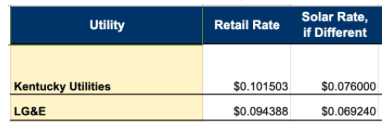 Kentucky’s solar program saw major changes in 2020 and 2021 – and we want to make sure you have all of the information as you make the choice to go solar.
Kentucky’s solar program saw major changes in 2020 and 2021 – and we want to make sure you have all of the information as you make the choice to go solar.
The main takeaway: Solar is still a great solution for customers in these utilities that are looking to control their energy costs, avoid rate increases, and generate their own power. Read on for our tips and tricks to help navigate the new Kentucky Power solar program and maximize your solar savings.
What changed? In 2020, Kentucky legislators turned the state solar program over to the utilities – and Kentucky Power tried to kill solar.
In most states, solar arrays on homes or businesses exchange power with the grid tit-for-tat. For example, a home’s solar system is cranking out energy in the middle of a summer day – way more than the home needs at that moment – and so most of that solar power flows onto the grid. This strengthens and supports the grid and solar homeowners are credited for the power they share with the utility. Later that evening, when the family is home and using power, the home draws back power from the grid. A simple exchange.
In 2020, Kentucky Power successfully petitioned the state legislature for authority over the solar reimbursement rate in their service area, and promptly proposed paying only a pittance to those pushing all that midday excess solar power onto the grid. At the same time, they proposed increasing their rates, pretty dramatically.
Kentucky Power’s proposal: to set the solar reimbursement rate at $.03/kWh, while raising it’s retail rates to about $.15/kWh. Kentucky Power wanted to credit solar owners just three cents for their excess solar power, and then charge them five times more to use it back later.
Public interest groups opposed the proposal, and won some concessions but the value of solar credits did change.
Consumer protection groups went up against Kentucky Power, and stopped the 3-cent plan. Homes that add solar will be credited $.096/kWh for all the solar power they share with the utility, and then will be charged their retail rate ($0.13-0.15/kWh) as they use that power back.
Other utilities follow suit.
Following Kentucky Power’s lead, LG&E and Kentucky Utilities proposed solar reimbursement rates lower than their retail power rates. As of January 2022, the rates were:

 How to beat the utility at their own game – go solar, generate your own power, and control your costs.
How to beat the utility at their own game – go solar, generate your own power, and control your costs.
When we build a solar proposal for customers in these three utilities, we make an assumption about how much power you’ll draw directly from your solar system as it’s produced, and how much you’ll draw from the grid, given the daily cycle of the average home. If you want to go above and beyond, here’s how:
The best way to hack the system is to use as much electricity as possible while the sun is shining and your solar panels are producing. The more you minimize the power you draw from the grid, the less you pay the utility’s rate and the more you maximize your savings.
- Plan to do your laundry during daylight hours, or check out your washing machine’s “delayed start” option.
- Schedule your dishwasher to run while the sun is still out.
- Have a slow cooker or crock pot? Avoid using your oven at nighttime and cook your dinner throughout the day.
- Working from home? Perfect! Do your job with solar-generated power. Flip off your power strip at the end of your workday.
- Love to tinker in your workshop? Try to use your most power-hungry tools in the daytime.
- If you know you’ll be away from the house, adjust your thermostat to align with when you’ll be home.
Want to hang onto your solar power, and just avoid the utility all together? Add a battery system to your solar.
Another smart way to keep the utility’s hands off your power is to invest in a solar battery. A battery stores the electricity your solar generates during the day and allows you to use it in the evening, after the sun sets. With a battery system, your power flows from the solar on your roof or out in your backyard, to the battery in your basement or utility room, to power your lights and appliances – all within your home. A solar battery also comes with the added bonus of providing backup power in the event of outages!
Get in touch with us if you have any additional questions about solar in Kentucky. We’re always happy to develop a (free) analysis for you and talk you through this complexity, so you can make the best, most informed decision for your home and your family.
Sources:


 Kentucky’s solar program saw major changes in 2020 and 2021 – and we want to make sure you have all of the information as you make the choice to go solar.
Kentucky’s solar program saw major changes in 2020 and 2021 – and we want to make sure you have all of the information as you make the choice to go solar.


